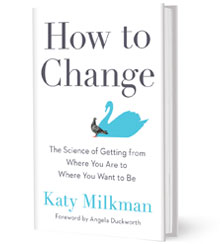Building a better you
In How to Change, Wharton professor Katy Milkman delves into the science that can help us make changes stick.
How to Change: The Science of Getting from Where You Are to Where You Want to Be
by Katy Milkman, Portfolio, 2021
A crisis — such as the COVID-19 pandemic — changes the way we lead our lives, often substantially. But when it’s over and things begin to return to normal, how many of the positive changes will stick? Will we continue to spend more time with family and exercise more regularly? And how do we overcome the very human tendencies toward temptation, laziness, under-confidence, or forgetfulness?
Setting overly ambitious goals and making grand plans can feel daunting. We become impatient for results, too. Instead, the trick is to understand your internal obstacles — or “opponents” — and select the right strategies to overcome them. This is the central premise of the eloquent, substantive, and uplifting book How to Change, written by Wharton professor Katy Milkman.
For Milkman, who was first featured in these pages as a “Young Prof” nearly seven years ago, it’s not that change is hard. Rather, she writes, “we often fail by applying the wrong tactics in our attempts at change.” For example, signing up for a gym membership, using a fitness app to track progress, and sharing you goals with friends won’t help much if you balk at the prospect of exercising. Finding a way to enjoy it more — by listening to audiobooks while working out, in the case of Milkman — brings a better chance of success.
Tricking yourself into effectiveness requires self-awareness, skill, and dedication. It’s a far cry from the quick fixes and one-size-fits-all strategies described in many self-help books. “In medicine, doctors recognize that chronic diseases require a lifetime of treatment,” Milkman writes. “Why do we assume that behavior change is any different?” Indeed, our internal obstacles to change are like the symptoms of chronic behavioral issues. The science Milkman champions focuses on diagnosing and treating these issues, and tracking progress.
Milkman has very specific prescriptions that have important implications for leaders in organizations. Be careful whom you spend time with. You’re more likely to achieve your goals if people around you show belief in your abilities, thus creating positive expectations. Offer advice to others, not just because people will benefit from your advice, but because you will benefit from the “saying-is-believing” effect.
The seven behavioral obstacles Milkman identifies — getting started, impulsivity, procrastination, forgetting, laziness, lack of confidence, and conformity — will be familiar to some readers. But How to Change stands out by describing precisely where and how strategies should be used to overcome these obstacles, supported by a strong body of research.
‘In medicine, doctors recognize that chronic diseases require a lifetime of treatment,’ Milkman writes. ‘Why do we assume that behavior change is any different?’
For example, we know that reminders are helpful ways to get us to vote, take medication, or wear a seat belt while driving. But to work effectively, it turns out, reminders must come just before the event in question. Specificity matters, too. Rather than saying, “I’m going to floss more regularly,” reframe the intention: “Every night after brushing my teeth, I’m going to floss.”
Some of Milkman’s advice is situation-specific. Pairing an activity you aspire to do with something you enjoy doing — so-called temptation-bundling — may work in a gym setting when you can do two activities at once (e.g., Milkman’s audiobooks), but is less likely to help if you’re doing “deep” work, such as writing an article or answering important emails. Similarly, gamification may help to engage people in an otherwise dull activity, but only if they’ve bought into it. Commitment devices — incentives for “locking us into choices we make when we’re clearheaded about what’s good for us” — differ in how “hard” they are, and both hard and soft ones can be effective. The prospect of paying a $16,000 fine — under the terms of a contract — incentivized one entrepreneur to fulfill his ambitious three-month goals (which included writing a book and going skydiving). By contrast, a group of doctors who signed and then displayed a formal pledge — a softer, reputational commitment — not to prescribe antibiotics unless they were necessary cut inappropriate prescriptions by a third.
A healthy dose of common sense — and humanity — helps when making changes. Grit and persistence only go so far. Milkman advises that “when you keep hitting a wall on a particular goal, it’s time to step back, reassess, and think about the bigger picture instead of making yourself miserable.” Don’t overengineer the solutions, either. For example, although we know that forming stable routines is key to habit formation, you must build in sufficient buffers for life events or hiccups that may make it difficult to follow your plan. Otherwise, you’ll end up disappointed and less likely to sustain your new behaviors.
In one experiment, those who were rewarded for exercising on a more flexible schedule kept working out a lot more at other times, too — not only at the time they’d said was most convenient. In this instance, a more flexible approach wound up embedding a new behavior. The others, who had agreed to exercise at a fixed time and day, Milkman writes, transformed from “Routine Rachels” into “Rigid Rachels.” That is, when events made it impossible to exercise at the regular time, they didn’t compensate by exercising at other times.
How to Change is a book for everyone, whether you are an executive, student, or family member. Covering a wide range of professional and personal situations, it provides a strong platform for further research into how to sustain changes, both in individuals and within teams.
Milkman is on a mission to increase the population of “sophisticates” — those who understand their behavior and want to change it. Leaders and managers should focus on upskilling the “naïfs” while also being wise as to where and how to rein in their behavior without being overly controlling. To her credit, Milkman applies a glass-half-full perspective on life and change, without being naive. Although we may be skeptical of the power of New Year’s Resolutions, she reminds us that they still work for 20 percent of people. Similarly, although we might expect customers to choose a flexible savings account (which allows withdrawals at any time), 28 percent of customers at a bank chose “locked” savings accounts (which penalize withdrawals) that pay the same level of interest. Those choosing the locked options saved 80 percent more. These are material changes in behavior.
The book — at times autobiographical — describes how Milkman practices what she preaches, whether it was trying tennis drills in different ways as a teenager or bundling household tasks with her temptations as a working parent. The description of the research experiments and life experiences are so clear that it’s hard not to try the experiments yourself as you read the book.
The experience of the COVID-19 pandemic has shown the resilience and frailties of the human condition in sharp relief. It has also shown our ability to change for the better. How to Change could play a pivotal role in helping us to sustain it.
Author profile:
- David Lancefield is a strategist and coach who has advised more than 35 CEOs and has led 15 digital transformations. He is a contributing editor of strategy+business, and he also hosts the interview series Lancefield on the Line and publishes the email newsletter Flashes+Sparks. Lancefield was a senior partner with Strategy&, PwC’s strategy consulting business.





